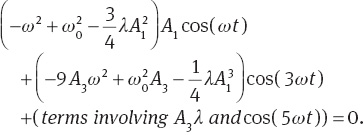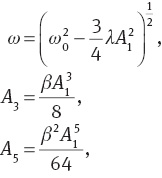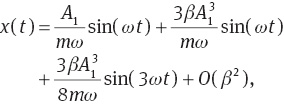Abstract
The modified Schrödinger equation due to its minimal length is considered useful for harmonic and linear potentials, as well as the free-particle case. Using basic concepts of quantum mechanics, the time evolution of these systems is reported.
1 Introduction
The Heisenberg commutation relation is supposed to be modified in the Plank length scale [1, 2]. Such modification, which is motivated by fundamental theories, such as string theory and quantum gravity, will change the mathematical form of our wave equations [1, 2]. In this field, the theoretical approaches become necessary due to the lack of a solid unified basis and experimental limitations [3, 4]. Consequently, various aspects of the problem have been analyzed so far. Das and Vagenas [3] indicated that the quantum gravity can influence almost any well-defined Hamiltonian. Maggiore and others tried to combine gravitation and quantum theory when minimal length consideration is taken into account [5–7]. In our work, we analysed the time evolution of modified nonrelativistic quantum systems of free-particle, harmonic, and linear terms. We first introduced the most essential formulae of the minimal length formulae, which is alternatively called the generalised uncertainty principle (GUP) formalism. It is well known that in the commutative formulation of quantum mechanics, the position and momentum operators satisfy the Heisenberg algebra [8]:

which corresponds to

where
For a detailed and instructive survey on various aspects of the GUP and the implications of the formalism on various interactions, the interested reader can read references provided [9–16].
2 The Time Evolution of the Modified Nonrelativistic Hamiltonian
The nonrelativistic Hamiltonian in ordinary quantum mechanics has the form

where

Ehrenfest’s theorem is not valid in the case of GUP [16], so we should take the classical limit by replacing commutators with Poisson brackets [17]:


We can note that the symbols without hats are c-number. This will lead to represent position and momentum operators as
From obtained relations, we calculate time evolution in different conditions.
3 The Time Evolution of Some Modified Hamiltonians
3.1 The Free-Particle Case
It is well known that the Hamiltonian of a free particle is

The latter, in the presence of minimal length considerations, is

According to (7) and (8),

and

Equation (12) recovers ordinary quantum mechanics relation when β→0.
3.2 The Liner Gravitational Potential
In the free-fall motion, gravity is the only force which acts on the object. If we consider gravity force in the direction of x-axis, the potential takes the form

and the modified Hamiltonian appears as

For this case

From the aforementioned relation we have

By substituting (16) into (7), we obtain


The latter, for vanishing minimal length parameter, gives the well-known relation

In Figure 1 we have plotted x versus the time.

Comparison of the position in both the presence of minimal length and vanish of minimal length.
3.3 The Harmonic Oscillator
The simple harmonic oscillator potential is one of the most important problems in both classical and modern physics and possesses the Hamiltonian as (4):


which gives

Substitution of (7) in (22) yields the nonlinear equation

In the last section when β→0, (23) is nothing but the well-known liner harmonic oscillator equation

(i.e., the minimal length has transformed the linear harmonic equation into a nonlinear counterpart). This condition enables us to use the method of successive approximations [18]. Writing

Equation (23) is more neatly written as

We now try a first approximation of the form

Substitution of (27) into (26) yields

or

An approximation to ω, which is valid for small λ, is obtained by equating the first term to zero. Such a procedure gives

which, as we expected, gives the frequency as a function of the amplitude. The other term will lead us to add the following second term to our trial solution:

By the same token of the previous lines, we find

In this stage, we equate the second term to zero and obtain

Therefore, our second approximation can be expressed as

The solution can be improved by adding an extra term:

which, after some simple calculations, gives

and

By substituting (37) in (7) we obtain time evaluation of position operator as

For vanishing GUP parameter, we recover the well-known sinusoidal term.
4 Conclusions
We considered the nonrelativistic time evolution of various interactions in the presence of a generalised uncertainty principle. For solving harmonic case we used the method of successive approximations and then provided an approximate analytical solution to the corresponding nonlinear equation. The solutions were reported in terms of cosine terms with arguments containing odd integer coefficients. In addition, we considered the free particle Hamiltonian and the linear term and reported the corresponding time evolution.
Acknowledgements
It is a great pleasure for the authors to thank the kind referees for their many useful comments on the original manuscript.
References
[1] H. Kragh, Am. J. Phys. 63, 595 (1995).Search in Google Scholar
[2] W. Heisenberg, Annalen der Phsik 424, 20 (1938).10.1002/andp.19384240105Search in Google Scholar
[3] S. Das and E. C. Vagenas, Can. J. Phys. 87, 233 (2009).Search in Google Scholar
[4] B. Bagchi and A. Fring, Phys. Lett. A 373, 4307 (2009).10.1016/j.physleta.2009.09.054Search in Google Scholar
[5] M. Maggiore, Phys. Lett. B 304, 65 (1993).10.1016/0370-2693(93)91401-8Search in Google Scholar
[6] M. Maggiore, Phys. Rev. D 49, 5182 (1994).10.1103/PhysRevD.49.5182Search in Google Scholar
[7] M. Maggiore, Phys. Lett. B 319, 83 (1993).10.1094/Phyto-83-319Search in Google Scholar
[8] S. Das, E. C. Vagenas, and A. F. Ali, Phys. Lett. B 690, 407 (2010).10.1016/j.physletb.2010.05.052Search in Google Scholar
[9] A. Kempf, G. Mangano, and R. B. Mann, Phys. Rev. D 52, 1108 (1995).10.1103/PhysRevD.52.1108Search in Google Scholar
[10] F. Scardigli, Phys. Lett. B 452, 39 (1999).10.1016/S0370-2693(99)00167-7Search in Google Scholar
[11] G. Amelino-Camelia, Phys. Lett. B 510, 255 (2001).10.1016/S0370-2693(01)00506-8Search in Google Scholar
[12] H. Hassanabadi, S. Zarrinkamar, and E. Maghsoodi, Phys. Lett. B 718, 678 (2012).10.1016/j.physletb.2012.11.005Search in Google Scholar
[13] T. L. Antonacci Oakes, R. O. Francisco, J. C. Fabris, and J. A. Nogueira, Eur. Phys. J. C73, 2495 (2013).10.1140/epjc/s10052-013-2495-6Search in Google Scholar
[14] S. Shams Sajadi, Eur. Phys. J. Plus 128, 57 (2013).10.1140/epjp/i2013-13057-5Search in Google Scholar
[15] H. Hassanabadi, S. Zarrinkamar, and A. A. Rajabi, Phys. Lett. B 718, 1111 (2013).10.1016/j.physletb.2012.11.044Search in Google Scholar
[16] K. Nozari and T. Azizi, Gen. Relativ. Gravit. 38, 325 (2006).Search in Google Scholar
[17] Z. Lewis, A. Roman, and T. Takeuchi, arXiv 1402,7191 (2014).Search in Google Scholar
[18] G. R. Fowles and G. L. Cassiday, Analytical Mechanics, Thomson, Washington, DC 2005.Search in Google Scholar
©2015 by De Gruyter
